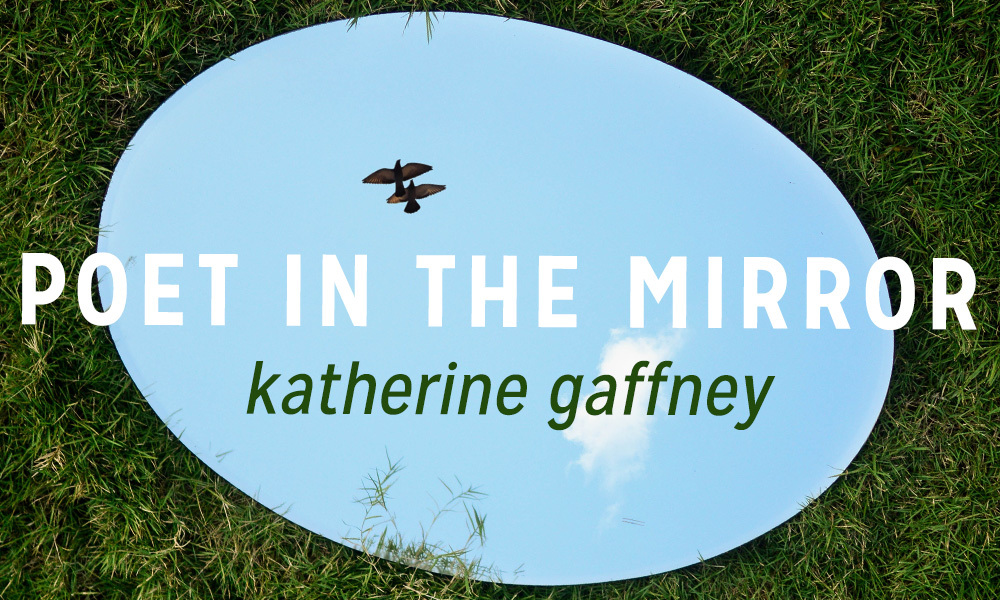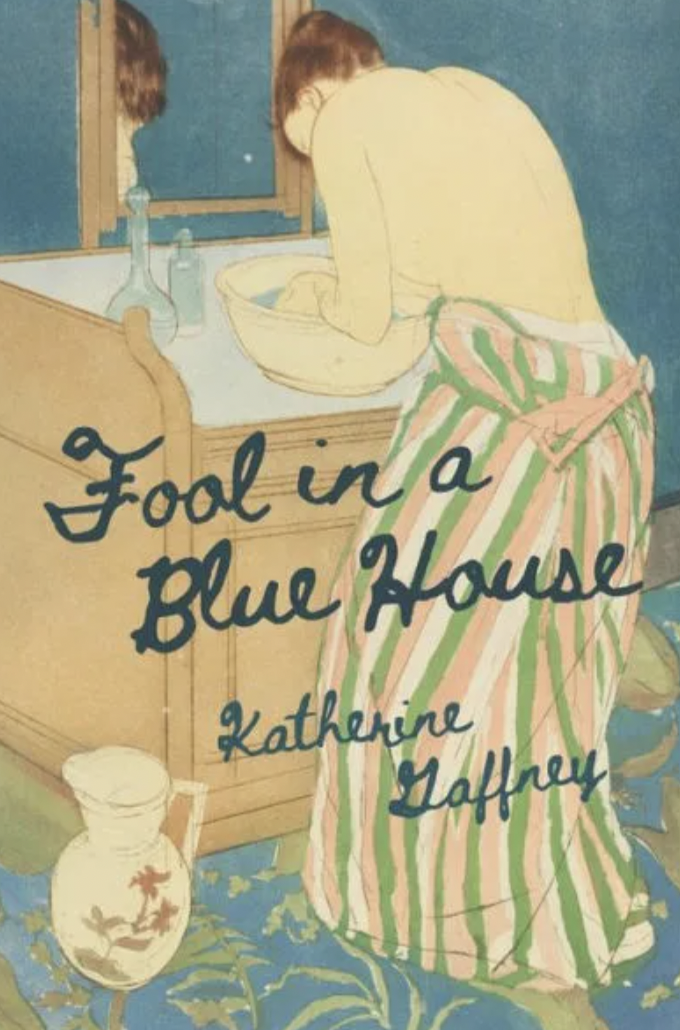Poet in the Mirror: Katherine Gaffney

We’re so proud to share some insight into the lives and hearts of today’s poets with our Poet In The Mirror series. This month, Katherine Gaffney—Frontier Poetry contributor and author of Fool in a Blue House (available now from University of Tampa Press)—shares insight into poetry as choral, arranging the furniture of a poem, publishing as an emerging writer, among other topics.
On Poetry as Choral
I really loved Fool in a Blue House. Congratulations on your debut! I’d love to talk a little bit about the way your own reading and scholarship informs this book–in addition to multiple epigraphs by woman writers (two by Adrienne Rich!), there is a poem that quotes Virginia Woolf. I’m curious not only about the process of choosing the many epigraphs that divide the sections, but how you see these voices informing your own work and thematic concerns.
Thank you so so much! What a lovely question to start this interview off! I seek for my poetry to be choral, to be in concert with so many incredible thinkers and writers that came before me, who laid down pavers for me and other fellow poets to tread as we continue to bring books into the world. So, that’s where I see the importance of conversation in the book whether through epigraph or quotations in the course of a poem.
A habit I try my best to maintain is to write down little snatches of poems or prose that resonate with me, which is how the epigraphs that divide the book into its sections emerged. But that being said, I don’t necessarily limit myself to what we might traditionally define as art–for example, a Lane furniture advertisement serves as an epigraph for a poem. Another poem weaves multiple epigraphs throughout the course of the poem to establish the identities of saints like Ebba the Younger and Wilgefortis who disfigured themselves in the name of their faith.
More broadly, research, as you suggest, deeply informs other poems like my rabbit hole of research into the nature of Marie Antoinette’s burial or my research into the iconography of heart symbolism leading me back to 14-century illustrations. In each of these modes, I suppose I find a way to make the personal more public, to give my meditations on, for example, my mother’s heart attack a connective thread outside of myself.
On the House
The invocation of “house” in the title immediately brings to mind the concept of the book’s architecture for me–how it’s put together, poem or stanza as room, the interior vs exterior of something, etc. How do you view these poems in relation to the structure of a house and/or the idea of dwelling?
Oh I love this question too. Gosh, what a joy to answer these questions!
This book in its early stages was titled No One Thought of Birds. Corey Van Landingham, who had just arrived at the University of Illinois as a Visiting Assistant Professor, upon reading the manuscript suggested a few different titles, one of which was Fool in a Blue House. In the throes of moving, I found her annotated copy of this early draft and all the different title suggestions she gave me. Back in 2019, we talked about how the “Fool” in Fool in a Blue House infused theater into the title’s structure which then gave birth to the five-part structure of the book, plucking at the structure of the five-act play.
So, in turning back to your question, I absolutely love that you’ve homed in on (an intentional pun here) the “House” in the collection’s title. In talking about my craft, I often talk about how I approach writing a poem as appointing a room with furniture, trinkets, windows, a space for readers to enter and explore for a while. And I cite the very etymology you’ve cited–that stanza’s italianate root means room!
To speak more globally outside the process of writing each poem, I definitely feel there is a sense of a layout to these sections, a sense of progression through the domestic from strictly familial toward cohabitating with a domestic and romantic partner as readers move toward the final section.
I paused here in answering this question and tried here to label one section the kitchen, another section a living room, but found myself getting tangled, so perhaps I’ll let readers draw their own conclusions about which section is which room in the house.
But I think your note about exterior versus interior in the book’s construction is so clever. I don’t know if I can claim full intention, but I do think there is a sense that the earlier poems in the collection are more contained within four walls and as the book concludes the poems put pressure on and eventually push out of the house structure. That final section in that pushing out of the house structure arrives ultimately at a release of the weight the collection bears–in relation to the web of relations its speaker is working to navigate–punctuated by that final poem (perhaps a kind of foyer or porch to the collection) that brings us completely outside the structure of the house to the open sky.
On Publishing
What advice would you give to emerging poets who are yet to publish their first book? Is there anything you wish you knew between your book’s first draft and final draft?
I still think of myself very much as an emerging poet so perhaps I see this as advice from one emerging poet to another, but I have two pieces of advice to give.
One is to give your book to a place you feel is the right fit for your collection, your voice, your poems.
Two is that I think especially with social media there is this pressure to publish young, to get the book out in stride with the MFA or the PhD, which, for some (not all of course) can become a restricting force.
I like to evoke Amy Clampitt here who was fifty-three when she published her first collection. I love Clampitt’s work and there is something about living, about experience, and perhaps about wisdom that comes with time (not just age) that can enrich poems. So, rather than think you’ve lost a window of time in which to find a home for your first book, think of it as a marinade for the poems already affixed in the collection and as places where you’ll find the right poem to fill that space.
To address the second question, given the amount of time between the first draft and the final draft–which for me was about five years–I don’t think I was prepared for how my relationship with the book and with individual poems would change so dramatically. Of course, intellectually I can understand that–as you reread books over your life your relationship changes, I think a really common example of that is The Great Gatsby—but there’s a different tenor when that reading relationship changes with your own work.
It’s been pretty stunning as certain poems suddenly become elegies or even eulogies over time. But I think the other surprise for me was how my relationship with drafts and drafting became very much like a sewing project in that as I reordered or replaced poems in the collection, I felt like I was ripping out seams, cutting a new swath of fabric to attach one panel to another, and restitching the collection back together.
On Origins
When did writing become a professional endeavor for you? How did that begin?
Perhaps one of the beauties of poetry is that it rarely fully becomes strictly a professional endeavor? But I became committed to poetry around the age of fifteen. I had an amazing high school English teacher, Dr. Michael Bassett, who gave me Sylvia Plath’s Colossus as I was flailing around writing an ill-defined and never to see the light of day language perhaps straddling poetry and prose. From there devouring book after book he leant and often gave to me, I began to realize poetry was my genre.
Working with Dr. B (as we affectionately called him), I began to publish my very first poems! Then, I was really lucky to work with William Logan while completing my bachelor’s degree at the University of Florida. He really helped sketch what graduate school in creative writing looks like and paved the way for that to become a reality for me. And from there, poetry has sort of come to frame my life and its path.
On Daily Writing
What is popular craft advice that you don’t practice yourself? (Or, what is craft advice you absolutely stand by?)
Oh this is a great question. I suppose I’ll out myself with the fact that I do not write everyday. Much as I admire people who ritualistically write daily and some even at the same time, I find I tend to go through spells of reading and then spells of writing.
I know the common wisdom reads that if you write daily you’ll produce more and the last few years I have pushed myself to do this in the April poem-a-day marathons, but I am not disciplined enough to do this year round.
In fact, sometimes I find I write better when I am doing the dishes or mowing the lawn. Perhaps in this, I am following commonly heeded advice–if memory serves me correctly this might be wisdom Richard Hugo eschews in Triggering Town–which dictates it’s best for a poem to unfold askew of your subject or argument, perhaps my writing process works in this way as well.
On Surprise
What was the most surprising thing–either a joyful one or a challenging one–about ushering your debut collection into the world?
I am really grateful to have experienced and moved through the publishing process once before with Finishing Line Press for my chapbook Once Read as Ruin. But perhaps the surprise I encountered with the publication of Fool in a Blue House is how even having been through the process once before, I feel like I am still learning how best to usher a collection into the world.
 Katherine Gaffney completed her MFA at the University of Illinois at Urbana-Champaign and is currently working on her PhD at the University of Southern Mississippi. Her work has previously appeared in jubilat, Harpur Palate, Mississippi Review, Meridian, and elsewhere. She has attended the Tin House Summer Writing Workshop, the SAFTA Residency, and the Sewanee Writers’ Conference as a scholar. Her first chapbook, Once Read as Ruin, was published by Finishing Line Press. Her first full-length collection, Fool in a Blue House, won the 2022 Tampa Review Prize for Poetry. Gaffney lives and teaches in Champaign, Illinois.
Katherine Gaffney completed her MFA at the University of Illinois at Urbana-Champaign and is currently working on her PhD at the University of Southern Mississippi. Her work has previously appeared in jubilat, Harpur Palate, Mississippi Review, Meridian, and elsewhere. She has attended the Tin House Summer Writing Workshop, the SAFTA Residency, and the Sewanee Writers’ Conference as a scholar. Her first chapbook, Once Read as Ruin, was published by Finishing Line Press. Her first full-length collection, Fool in a Blue House, won the 2022 Tampa Review Prize for Poetry. Gaffney lives and teaches in Champaign, Illinois.